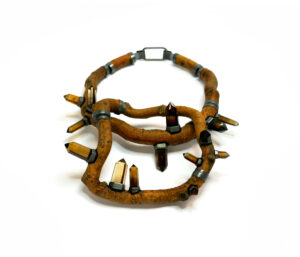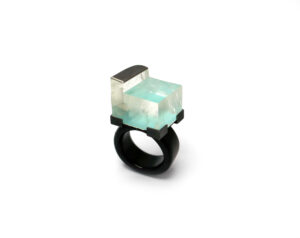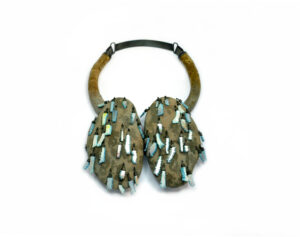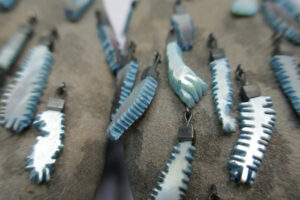Episode 222
What you’ll learn in this episode:
- How Terhi’s work changed as she moved from Finland to Amsterdam to France
- How the weather influenced Terhi’s recent exhibition at Ornamentum Gallery
- How jewelry can help us explore the relationship between man and nature
- Why Terhi creates her work on a mannequin, and how she lets materials tell her what they want to be
- Why love is the most important thing an artist can put in their work
About Terhi Tolvanen
Currently based in the French countryside, Terhi Tolvanen was born in Helsinki, Finland (1968). Following studies at the Lahti Design Institute, Finland, and the Gerrit Rietveld Academy, NL, Tolvanen earned a Master’s Degree in Jewelry at the Sandberg Institute, Amsterdam, NL.
Tolvanen’s works can be found in numerous distinguished private and public collections worldwide, including the Swiss National Museum, the Victoria & Albert Museum (London, UK) the Dallas Museum of Art (TX- USA) among others.
Photos:
“Wild frontal”

“Illution of Space”

“Breathing Rocks”

“Breathing Rocks detail”

“Big Pearl Bloom detail”

“Big Pearl Bloom”

Additional Resources
Transcript:
Terhi Tolvanen’s jewelry isn’t made of gold or diamonds, but in its own way, it’s just as precious. The Finnish jeweler uses natural materials like wood, raw minerals and shells to create jewelry that not only looks beautiful, but challenges viewers to reflect on the world around them. She joined the Jewelry Journey Podcast to talk about how her daily walks shape her work; how living in Amsterdam and rural France have changed her jewelry over the years; and her advice for emerging artists. Read the episode transcript here.
Welcome to the Jewelry Journey, exploring the hidden world of art around you. Because every piece of art has a story, and jewelry is no exception.
Sharon: Hello, everyone. Welcome to the Jewelry Journey Podcast. This is the first part of a two-part episode. Please make sure you subscribe so you can hear part two as soon as it’s released later this week. We’re so glad you’re here today.
I’d never heard of our guest, Terhi Tolvanen, before. I’ll let her pronounce the name in Finnish. I don’t know how I missed her jewelry because I like large, statement-type pieces, and that’s what many of Terhi’s pieces are. I was really taken with them. She uses a lot of materials found in nature, integrated with stones that we might see in other jewelry. Her work can be found in many prestigious museums around the world. She herself has studied in several countries, growing and perfecting her work. Today, we will learn a lot about Terhi and the inspiration and ideas you will find all around her. Welcome to the podcast, Terhi.
Terhi: Thank you so much, Sharon, for inviting me. It’s great to be talking with you.
Sharon: I’m so glad that we have the chance to talk. Can you tell us why you moved from Finland to Amsterdam to France? Can you tell us how the materials varied in each area?
Terhi: I moved away from Finland. Originally, I was supposed to be going away for only one year, but after technical school, I was missing quite a lot to learn more about the reasons why to make things. At the time in Finland, there was no possibility to continue. That’s why I started looking elsewhere.
I ended up then studying in Rietveld Academy in Amsterdam, in the Netherlands, and I totally fell in love with the school. The one year I was supposed to stay became six years. After four years, I also did a master course over there, and after school I stayed because it was great. I fell in love with jewelry. There were galleries, there were events, there were colleagues, there were things happening. During the school years, I made a lot of friends, and I found a place to stay and all that. Now for about 10 years, I’ve been in France. I moved to France because of love. I fell in love.
Sharon: okay. And did you find materials different in each area?
Terhi: The materials, yeah, of course. Moving to France has changed the accessibility to my materials totally, because I moved to the countryside from the city. This meant that I was able to use more and more branches that I could collect and find a little bit everywhere. And I’ve continued what I started doing already in the Netherlands for finding all my minerals and stones. I would go to mineral fairs. Now that I’m in France, I go to Paris.
Sharon: Are there are a lot of materials in Paris? Do you find things to work with?
Terhi: There is a quite good mineral fair once a year, in the beginning of December. I almost always have to wait one year if I want to have something or find the same thing again or find new material. When I do that, I have to count that I have enough for working for one year. I buy a lot and I don’t always use everything. Sometimes it can even take up to five years before I really know what I want to do with certain minerals, but this is always very exciting for me. I’m a very big fan of minerals and stones in any shape and color and format.
I have used a lot of rough minerals that I would cut just a little bit so that the dimensions would fit on a piece. For about three or four years, I’ve also been buying some cut stones. When I still lived in Amsterdam, I used to work with a stone cutter who would cut stones especially for me, and that was a very good cooperation. Since then, he has stopped working a little bit in that way. But he would save me things the normal goldsmiths wouldn’t want to buy. He learned very quickly that was interesting for me. Mainly it was things that were a little bit different, a little bit less perfect than a traditional goldsmith would want to use.
Sharon: How long have you been a maker? Did you choose it later or did you choose it when you were young?
Terhi: I have been a maker since my graduation from the Sandberg Instituut. The master course in Amsterdam is called Sandberg Instituut. I graduated from there in 1999, and I had my first solo show in 2000. Of course, it took a little time to get going. But now it’s 24 years ago. It’s long.
Sharon: And you knew when you graduated that you wanted to be a maker or a jeweler. That’s what you wanted to do professionally.
Terhi: Yes. I was asking this question a lot while studying. When I started studying in Amsterdam, I was absolutely convinced that I don’t want to be an artist and I don’t want to make jewelry. But I thought, “Never mind. I will be able to learn a lot of important things anyway at school.” This meant that during a lot of school years, I was trying all kinds of different things. I was drawing a lot, I was making objects, I was working a lot with textiles, sort of half- clothes, half-sculpture pieces.
And then at one moment towards the end of the master course, when it really became a reality that soon I will have to get out of the school and go into the real world, I really decided, “Okay, I will make jewelry,” because my conclusion, after all these school years, was that that’s the thing I can do the best. So, I really chose it. Also, because of the situation at the time in the Netherlands, it was possible to ask for working grants for jewelry arts. I had some very good school friends that were very much encouraging me to take the jewelry direction. So, yes, it was a very conscious decision at the time, and I have not regretted it.
Sharon: It was long periods when you were in a country. You said you were in Amsterdam for six years. Did you teach? I don’t know, maybe I have that wrong.
Terhi: No, not there. I was there for school for six years altogether. Also, I stayed for the reason that it was cheaper to work at school than rent a studio. When I graduated from the Instituut, I stayed in Amsterdam because it was, work wise, very exciting to stay there. I had a job on the site. Then later I got a working grant. I had a nice studio, so I stayed in Amsterdam until 2013 when I moved to France.
Sharon: I have to ask if you knew the languages before you came to each country. Well, English in Amsterdam works. What languages do you speak?
Terhi: I’m multilingual. in Amsterdam I decided that I would like to learn Dutch because I thought it is very important for the quality of life. I managed to learn Dutch, so I speak Dutch quite fluently. At school it was a lot in English, of course. I speak Finnish, Dutch, English, and now in France, people don’t speak so much English, so I really had to learn French. I had already studied French during all my school time in Finland, so I had a base for that, but I couldn’t speak it so well. Now, of course, with all the years, I have learned to speak French. I’m teaching now in France at ENSAD Limoges, the École Nationale Supérieure d’Art et de Design, which is one of the national art schools. I’m teaching in French.
Sharon: As you learned each language, did your works change? Did it make it easier to work or harder? Did you see a change in your work?
Terhi: Well, living abroad, it’s often lost in translation, of course. To know a language very well, you need to also understand the mentality and the culture of each country. I don’t know if it’s so much the language that’s influencing the work. It’s more the physical fact being in a certain place with certain surroundings. Of course, for me nature is very important. It’s a richness, the language is. Definitely, yes.
Sharon: Your most recent exhibition, I don’t know if you had another one since then, but last summer you were at Ornamentum Gallery. Your work was shown at Ornamentum Gallery, which is in Massachusetts, I think.
Terhi: It’s in Hudson, New York.
Sharon: Okay. I couldn’t remember. Hudson, New York. The exhibit was called Moderate to Southwest Winds. What does that mean in jewelry? What did you think it meant?
Terhi: I chose the title. It’s a weather forecast. It’s taken out of a weather forecast. I chose that because while working for that show, I realized that what is really making the rhythm of my work and my thinking is the weather. I go out every morning for a walk, and this is a very important moment for me depending on the face in the work. Either I try to just empty my mind and observe things in nature. I look at colors and light and shapes and textures. Or, when I’m a little bit further in the work, then the moment of walking is very nice for finding solutions, so I’m working in my head.
And, of course, what is then very important is the weather. If it’s nice weather, if the sun is shining, if it’s raining, if it’s the spring or the winter. In wintertime, there is not so much light, so I have to wait for the light to be able to go out. This is totally deciding the rhythm of my day. As I also wrote at the time for the text of the exhibition, all my life I’ve been following the weather forecast. I check every morning what kind of weather it’s going to be. I plan my day. If it’s raining in the morning, I will go and do my walk in the afternoon and so on. This is something that I learned from my grandfather in Finland who had a little summer cottage on a little island. It’s important to know what kind of weather it is, if it was safe to take the boat to the mainland or not. This is a kind of habit. It’s sort of a daily ritual for me.
I was also thinking that as the weather is the factor that is so important, I can also say that what was a little bit different for this exhibition was that the theme was a little bit more general. I let myself have the freedom of not deciding so tightly the theme that I’m working on. During COVID, I had put aside all kinds of different plans, all kinds of pieces that I wanted to make but I was not able to make at the time. I also had some materials that they had put on the site especially for the show at Ornamentum. I decided to make the show in that way, that I will make all these pieces that were waiting to be made. I found that, like the weather, the circumstances of the situation led to that conclusion somewhat and what I could say.
Sharon: How did COVID affect you and your work?
Terhi: I found it a very, very difficult time. I didn’t stop working totally, but I was not able to really make my big pieces. It was quite military like, I would say. How to explain? The French system was very strict. To go out, you had to sign a paper and you had to tell what you were going to do, and you had one hour to do that. If you would not be back at home on time, then you would get fined. There was a very efficient fear campaign on television and so on.
It felt very uncertain, and I’m sure this was the case for everybody. It took away a lot of the safe feeling which is necessary to be able to really dive into a big work. In a way, the time was cut in small moments when it was possible to create. Ever since I started working, I think the COVID year was really the first year that I didn’t have so much production.
Sharon: Were you allowed to go out to your studio? Is your studio in your home or is it separate?
Terhi: At the time, I had a studio in a little town close to home. When they announced that the lockdown is going to come, I moved the most important things from my studio to my home so then I didn’t have to go. This would have been possible. I could have signed the paper and said, “I’m going to my work,” but I felt better working at home. Also, being in the countryside, it was more free to go out. It was an isolated house at the time. I have moved since, but it was much easier to be there than in a city situation. I’m glad I did it. I moved my goldsmithing bench and my main tools and my main materials.
Sharon: You moved them home?
Terhi: Yeah, I had a little room at home to be able to work.
Sharon: What did you want them to learn from the exhibition? Let’s say your show at Ornamentum was the first time they were seeing your work or contemporary jewelry. What did you want them to learn by looking at it?
Terhi: I’m very concerned about wearability in my work. This gives the scale. For somebody who is not so acquainted with contemporary jewelry, a lot of times people find it very big. I like to say that my work is sculpture. Then one could say that it’s wearable sculpture.
I’m also, first of all, talking about nature since the beginning. I’m working on the same theme in a way for about 20 years. I never changed because there are always new things. What I want to really put in the front—this is a little bit of a French saying, sorry—is that nature is very precious, and there are a lot of very beautiful things to see. How to put it very simply? I just want to show that it’s very special. There are a lot of little things you can see when one walks in the forest. It’s worthwhile to really look.
This sounds a little bit like no explanation because there are so many factors. But I’m talking about a dialog between man and nature. I’m talking about respect towards nature. I’m talking about this kind of eagerness to control nature, and the nature is fighting back so this dialog is never ending. Of course, today this is a topic that is more actual than ever. There are so many wonderful things. It’s amazing, I think. I mean, just the mineral world. It’s amazing what nature can make.
Sharon: We will have photos posted on the website. Please head to TheJewelryJourney.com to check them out.
Thank you again for listening. Please leave us a rating and review so we can help others start their own jewelry journey.

